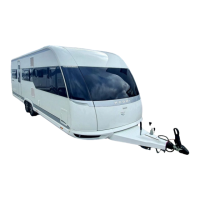Electrical Installations
06-8
The battery voltage of both the engine battery and the cara-
van battery can be checked continuously on the on-board
control panel located above the entrance door.
The battery charger only works if the batteries have been
inserted with their poles in the right direction.
A discharged caravan requires a charging period of approx.
12 hours on the electric mains to completely recharge itself.
This charging period must be extended accordingly if equip-
ment that uses 12 V is switched on at the same time.
Protection against total discharge
If the battery voltage of the caravan battery sinks below 10.5 V,
a relay shuts down all the equipment that uses voltage.
If the protection against total discharge takes effect, turn
off the 12 V master switch to avoid an additional discharge
of the caravan battery.
Function of the battery charger
Protecting the device
If the battery charger should become hot because of high en-
vironmental temperatures or high charging currents, a built-in
thermal switch turns off the battery charger until the temperature
in the battery charger has dropped again.
Checklist
• Turn off the motor.
• Turn off the mains switch on the battery charger.
• Connect the battery charger to the mains supply.
• Switch on the 12 V master switch.
• Turn off all equipment (except refrigerator) that uses 12 V.
• Turn on the mains switch on the battery charger.
The voltage of the caravan battery must rise to a maximum
voltage of 14.4 V.
If this does not happen after using the built-in battery charger
to charge the battery, check the following:
• Has the battery charger been properly attached to the net-
work?
• Is the mains fuse of the battery charger functioning proper-
ly?

